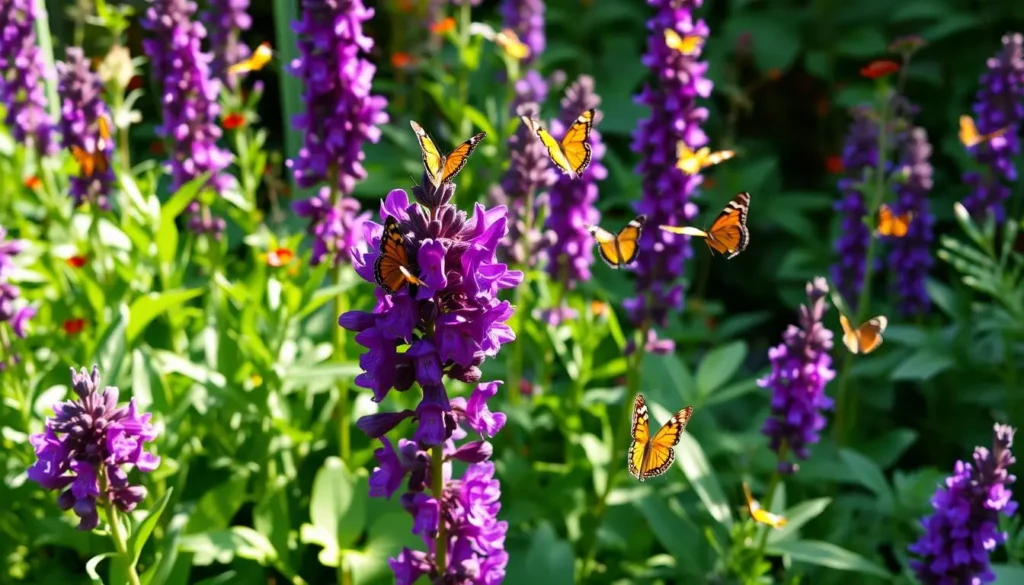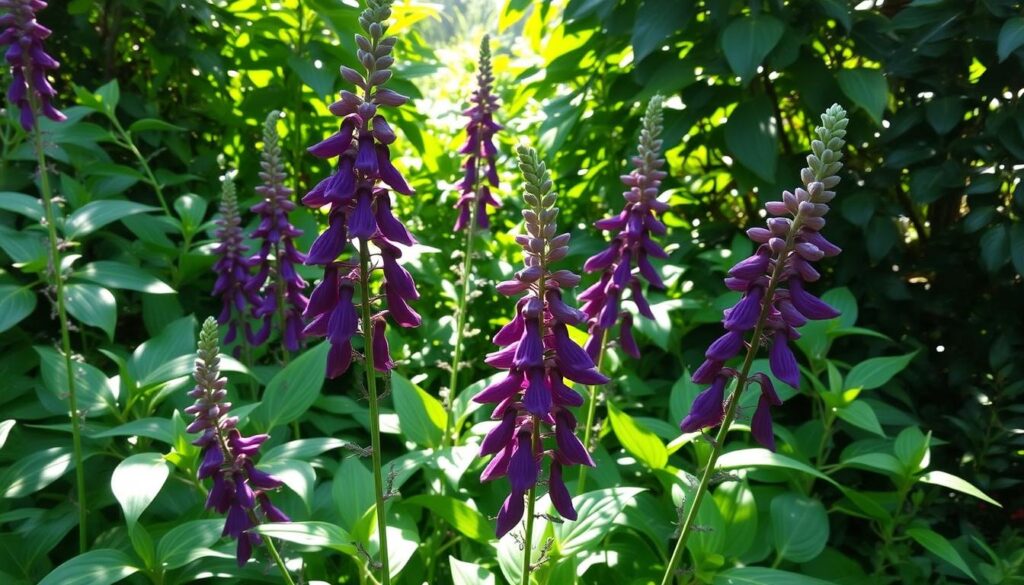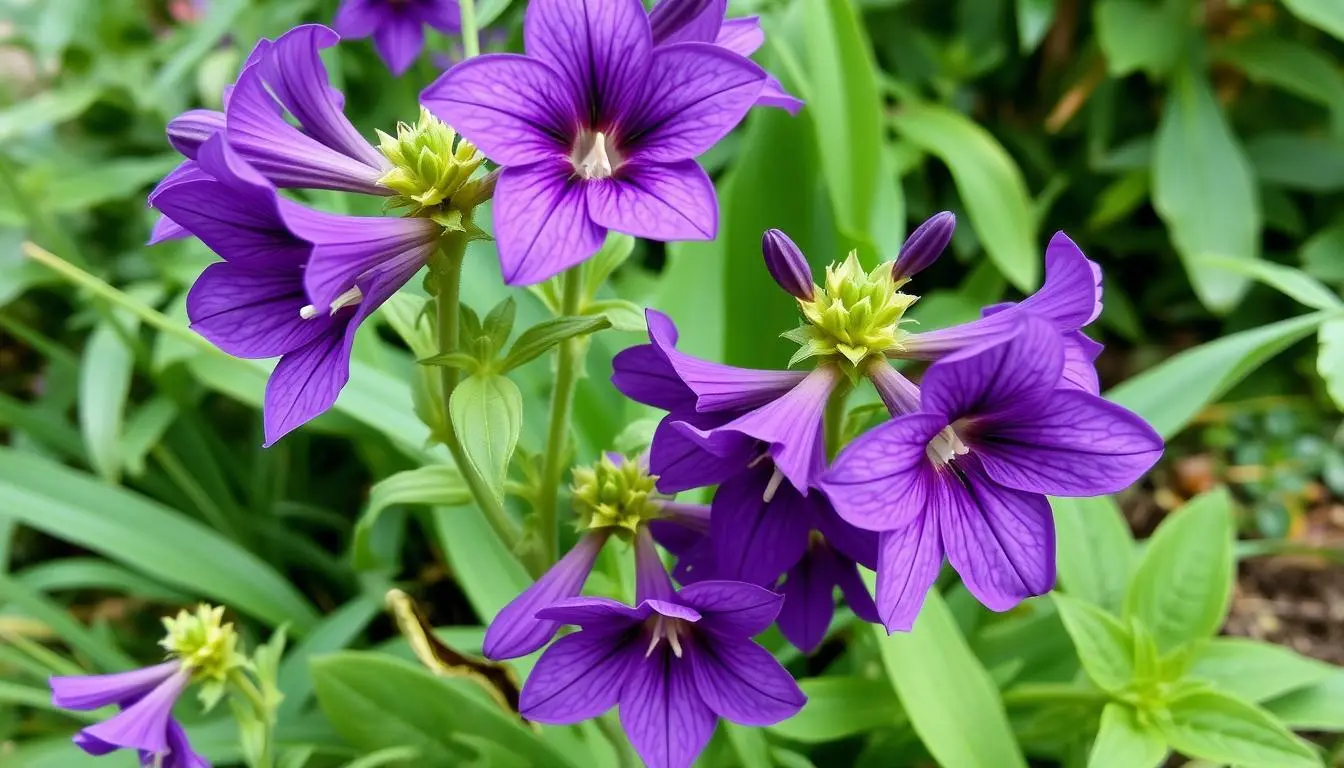I love gardening and the beauty it brings. Spring’s colors and the lasting foliage of plants tell their own stories. Today, I want to share with you the Baptisia Dutch Chocolate, a standout perennial that has won my heart.
This North American native boasts rich purple flowers and stands tall. It’s easy to care for and can handle drought. Plus, it draws in butterflies and pollinators, making it even more special. As you learn about Baptisia Dutch Chocolate, I hope you’ll see why I adore it so much.
Table of Contents
Introduction to Baptisia Dutch Chocolate
Baptisia Dutch Chocolate is a stunning perennial plant in the legume family. It has dark purple flowers and unique foliage. It’s a favorite among gardeners and plant lovers. Let’s explore its origin, development, key traits, and classification.
Origin and Development
Baptisia Dutch Chocolate was developed in the 1990s. It’s a mix of different Baptisia species. This mix improved its form, flower production, and purple color.
Key Characteristics
This plant can grow up to 3 feet tall. It blooms in late spring to early summer. The dark purple flowers stand out, and the blue-green leaves add beauty.
Plant Classification
Baptisia Dutch Chocolate is a perennial in the legume family, Fabaceae. This family includes beans, peas, and ornamental plants like Baptisia. As a perennial, it comes back year after year, making it easy to care for.
“Baptisia Dutch Chocolate is a true showstopper in the garden, with its rich, dark purple flowers and distinctive foliage.”
Understanding the Rich Purple False Indigo Plant
The Baptisia Dutch Chocolate is a stunning perennial plant. It’s part of the Fabaceae family of false indigo. This hybrid, from the Decadence series, has striking brown and purple flowers that bloom in June.
It also has attractive foliage and is drought-tolerant. This makes it perfect for gardens that need little care.
The Baptisia Dutch Chocolate grows into a bushy, compact shape. It adds depth and texture to any garden. Its lush, drought-tolerant foliage is eye-catching all season, even after the flowers are gone.
“The Baptisia Dutch Chocolate is a true standout in the garden, with its unique color palette and low-maintenance nature.”
Plant it as a border, in a naturalistic garden, or with other plants. The Baptisia Dutch Chocolate will draw attention from everyone. Its attractive foliage and drought-tolerant traits make it a reliable choice for your garden.
Growing Requirements and Climate Preferences
The Baptisia Dutch Chocolate is a beautiful native plant and tough perennial. It needs certain growing conditions to thrive. It likes well-drained, slightly acidic soil with a pH of 6.0 to 7.0.
It can grow in many soil types, like sandy or clay, as long as it drains well.
Soil Conditions
Baptisia Dutch Chocolate plants do well in loamy, humus-rich soils. These soils keep moisture but don’t get too wet. They can handle poor soil and don’t need much fertilizer. This makes them great for low-maintenance gardening.
Sunlight Needs
These perennials love full sun, needing at least 6 hours of direct sunlight daily. They can handle some shade, but their purple blooms will shine more in the sun.
Temperature and Hardiness
Baptisia Dutch Chocolate is a hardy native plant. It can handle cold winters and hot, humid summers. It grows well in USDA Hardiness Zones 4 to 9. This makes it a good choice for many places in the United States.
“Baptisia plants are a low-maintenance, drought-tolerant addition to any perennial garden or border.”
Planting and Establishment Guidelines
Adding the beautiful Baptisia Dutch Chocolate to your garden is a big step. It’s a herbaceous perennial and native plant that will make your garden pop. Follow this guide to plant it right and watch it grow.
Spring or fall are the best times to plant Baptisia Dutch Chocolate. This lets it grow strong roots before harsh weather hits. Pick a spot that gets lots of sun or partial shade. This native plant loves these conditions.
- Start by loosening the soil 8-12 inches deep. Add compost to help with drainage and nutrients.
- Plant the Baptisia Dutch Chocolate 3-4 feet apart. This gives them room to spread out.
- Plant it at the same depth as before. This helps it settle in faster.
- Water well after planting. Keep an eye on the soil and water when it’s dry.
Baptisia Dutch Chocolate takes time to grow. It might take 2-3 years to bloom fully. But with patience and care, you’ll see its beautiful purple flowers and lush leaves.
“Baptisia Dutch Chocolate is a true garden gem, offering a rich, velvety-purple display that commands attention.”
Follow these tips to add Baptisia Dutch Chocolate to your garden. It’s a stunning and easy-to-care-for native plant that will make your garden stand out.
Seasonal Care and Maintenance Tips
Caring for your Baptisia Dutch Chocolate plant is easy. It’s low-maintenance and drought-tolerant. As a perennial, it needs little care all year, perfect for busy gardeners.
Spring Care
In spring, your Baptisia Dutch Chocolate comes back to life. It’s a great time to give it some care. Start by pruning dead or damaged leaves gently.
Don’t cut back too much. A light trim encourages new growth and keeps it looking neat. Also, use a balanced, slow-release fertilizer to feed it for the season.
Summer Management
When it gets warmer, your Baptisia Dutch Chocolate does well with little water. It’s drought-tolerant, so it can handle dry spells. But, if it gets really hot or dry, water it a bit.
Otherwise, just sit back and watch it shine. This vibrant plant will be the star of your garden.
Fall and Winter Preparation
As the seasons change, your Baptisia Dutch Chocolate starts to rest. In the fall, let the leaves stay. They protect the roots during cold weather.
When winter comes, the plant rests. It needs almost no care until spring starts again.
Baptisia Dutch Chocolate is a low-maintenance, drought-tolerant perennial. Follow these easy tips for a beautiful, purple false indigo year after year.
“Baptisia Dutch Chocolate is a true garden workhorse, thriving with little effort and providing a reliable pop of color year after year.”
Benefits of Growing Baptisia Dutch Chocolate
Baptisia Dutch Chocolate, the captivating false indigo plant, offers many benefits. It’s a native plant that supports local ecosystems and boosts biodiversity. It’s especially good at attracting butterflies, making it perfect for butterfly-friendly gardens.
This plant is also deer resistant. It’s a great choice for gardeners who fight deer browsing. Its tough nature means you can enjoy its lush foliage and stunning purple blooms without worry.

“Baptisia Dutch Chocolate is a true gem in the garden, captivating with its rich color and wildlife-friendly nature.”
Baptisia Dutch Chocolate is easy to care for and can handle drought. It’s a great pick for adding elegance and resilience to your garden. Its deep roots and adaptability to different soils make it a reliable choice.
- Attracts butterflies and other pollinators
- Deer resistant, protecting your garden from unwanted browsing
- Contributes to native ecosystems and promotes biodiversity
- Low-maintenance and drought-tolerant, requiring minimal care
Adding Baptisia Dutch Chocolate to your garden brings beauty and health to your local environment. It’s a versatile plant that makes any garden better. It’s perfect for those who want a thriving outdoor space.
Common Pests and Disease Management
The Baptisia Dutch Chocolate is a tough and easy-to-care-for plant. It usually doesn’t get sick or get pests. But, sometimes it might face problems that need your help.
Prevention Strategies
Keeping your Baptisia Dutch Chocolate healthy is the best way to avoid problems. Make sure it has good soil, enough sunlight, and the right amount of water.
- Check the plant often for signs of pests or diseases, like yellow leaves or weird growth.
- Keep the area around the plant clean by removing leaves and debris. This helps prevent pests and diseases.
- Use organic mulch to keep weeds away and keep the soil moist. This can help keep pests away too.
Treatment Options
If your plant gets sick or gets pests, act fast. You might need to use special pest control or fungicides to fix the problem.
- For pests like aphids or leaf beetles, try using insecticidal soap or neem oil.
- For fungal diseases, like powdery mildew, use baking soda or copper-based fungicides as directed.
- Trim off any parts of the plant that are really sick to stop the problem from spreading.
By taking good care of your Baptisia Dutch Chocolate, it will stay healthy and beautiful for a long time.
Companion Planting and Garden Design
The Baptisia Dutch Chocolate is a stunning native plant with rich purple foliage. It can be a great addition to your garden. Pair it with other plants to enhance its beauty and growth.
The Echinacea purpurea, or purple coneflower, is a great match. These plants share a similar color palette, creating a striking contrast. The Baptisia’s tall stems make a perfect backdrop for the Echinacea’s vibrant blooms.
- The Rudbeckia hirta, or black-eyed Susan, is another excellent choice. Its golden yellow flowers contrast beautifully with the Baptisia’s deep purple. Together, they form a stunning combination.
- For a more subtle look, try pairing the Baptisia with Salvia nemorosa, or woodland sage. The soft blue-purple flowers of the sage complement the Baptisia’s foliage, creating a soothing garden design.
The Baptisia Dutch Chocolate is versatile and can thrive in many settings. It can be a centerpiece or part of a larger planting scheme. This native perennial adds elegance and charm to your outdoor space.
“The key to creating a beautiful and harmonious garden is to choose plants that complement each other in terms of color, texture, and growth habit.”
By choosing the right companion plants, you can create a garden that’s both beautiful and sustainable. The Baptisia Dutch Chocolate showcases the versatility of native plants in landscape design.
Propagation Methods and Techniques
The baptisia dutch chocolate is a versatile native plant. It offers gardeners different ways to grow more. Learning how to start seeds and divide plants is crucial for success.
Seed Starting
Starting baptisia dutch chocolate from seed is fulfilling. Seeds need cold to wake up, so sow them in fall or early spring. Use a seed-starting tray with good drainage and plant seeds 1/4 inch deep.
Keep the soil moist and the temperature between 60-70°F. Once seedlings appear, slowly get them used to outdoor life. Then, move them to your garden.
Division Process
- Baptisia dutch chocolate grows in clumps, making division a great way to spread it.
- Divide in early spring when new growth starts.
- Dig up the whole plant, keeping as much root as you can.
- Split the plant into sections with a sharp tool, making sure each has roots and a growth bud.
- Plant the sections 2-3 feet apart in good soil and water well.
Both seed starting and division can lead to strong, healthy baptisia dutch chocolate plants. This lets you grow more and share this native beauty with others.

Landscaping Ideas with False Indigo
Baptisia Dutch Chocolate, with its dark purple flowers and attractive foliage, is perfect for landscaping. It fits well in both formal and casual gardens. This plant is versatile and can blend into many settings.
Use Baptisia Dutch Chocolate as a focal point for a bold look. Its dark purple flowers and attractive foliage are great for drawing attention. Pair it with other colors and textures for a striking contrast.
“Baptisia Dutch Chocolate’s unique hue and architectural form make it a true standout in any garden setting.”
In cottage-style gardens, Baptisia Dutch Chocolate shines with other perennials. Its attractive foliage and dark purple flowers add to the lush, informal look.
For a cohesive design, use Baptisia Dutch Chocolate in borders and edging. Its strong form and attractive foliage contrast well with softer plants. This helps frame the garden.
Baptisia Dutch Chocolate fits many landscaping styles. It brings bold color and interest to your garden.
Harvesting and Uses in Garden Aesthetics
The baptisia dutch chocolate plant is more than its dark purple flowers and attractive foliage. It’s also great for cut flowers or dried arrangements. This adds natural beauty to any garden.
In spring, the baptisia dutch chocolate blooms with vibrant dark purple flowers. These flowers are perfect for bouquets and floral displays. They last long and add a unique touch to your arrangements.
- Cutting the flowers just above a leaf node helps the plant thrive and bloom again.
- Dried seed pods from the baptisia dutch chocolate can be harvested in fall. They add texture and interest to dried arrangements.
The beauty of baptisia dutch chocolate doesn’t stop there. Its attractive foliage and architectural seed heads interest the eye all year. This makes it a valuable part of any garden design.
“The baptisia dutch chocolate plant is a true four-season wonder, with its captivating blooms, lush foliage, and striking seed pods.”
For a cutting garden or to enhance your landscape, baptisia dutch chocolate is a great choice. It’s versatile and rewarding. Its diverse uses and year-round appeal make it essential for gardeners wanting to add elegance to their outdoor spaces.
Conclusion
The Baptisia Dutch Chocolate is a stunning native perennial. It’s versatile and easy to care for. This plant boasts a captivating color and many ecological benefits.
This guide has covered the Baptisia Dutch Chocolate’s origins, key traits, and growing needs. You’ve learned about its ideal soil and sunlight requirements. It’s also great for companion planting and garden design.
If you’re a seasoned gardener or new to native plants, consider the Baptisia Dutch Chocolate. It’s easy to care for and thrives in many climates. Adding this plant to your garden will bring beauty and help your local ecosystem.

